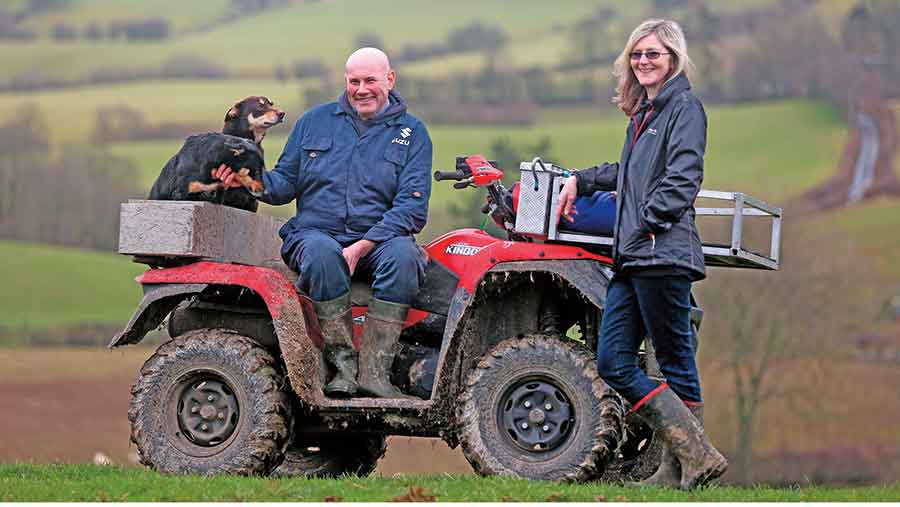How Powys hill farmers are overcoming drop in support
Following severe snowfall in 2013 that left their beef and sheep enterprise reeling from the effects of high feed costs, Powys farmers John and Sarah Yeomans concluded they either had to sell up or make some fundamental changes to their business.

© Richard Stanton
Brutal cuts to single farm payments further prompted the couple to explore rotational grazing and in the past two years they have halved feed costs by boosting live weight production from grass.
“We are going to lose 57% of our payments as a result of the change to area payments so I knew something had to change. [It was either that] or we would go bust and I didn’t want to go bust,” he adds.
We are going to lose 57% of our payments as a result of the change to area payments so I knew something had to change John Yeomans
See also: How a Welsh hill sheep farm is using EID
The couple, who run 70 suckler cows and a flock of performance-recorded Beulahs near Newtown, began rotational grazing of stock in 2014.
And even though John admits he still isn’t doing it “by the book”, he says their production a hectare has lifted compared with when they practised set stocking, which has enabled them to increase stocking rates.
“We’ve added about 20 ewes and 20 ewe lambs and another 10 or so cows.
“Rotational grazing gives you at least 20% extra growth so you can have another 20 acres [8ha] of ground for spending about £1,000 on electric fencing equipment.”
In comparison, if he bought an additional 20 acres (8ha) at £10,000/acre it would cost £200,000, he explains.
Rotational grazing strategies
At Llwyn Y Brain Farm sheep are grazed behind an electric fence, with fields back-fenced to allow sufficient regrowth.
Sheep are lambed indoors in March/April and are turned out in late May. Top genetics are put back to a Beulah to produce 300 pure replacements and the remainder is put to a Bluefaced Leicester, with ewe lambs mated to cross-bred rams to improve prolificacy.
Ewe lambs are sold as replacements, with more than 400 lambs sold finished last year.
See also: Cut concentrate costs by rotational grazing sheep
All stock on the farm is rotationally grazed. On the lower ground, more than 200 replacements are being run in one mob and shifted to a new paddock every four days to meet feed demand. The aim is to turn lambs into grazing covers of 2,000kg DM/ha and leave residuals of 1,200kg DM/ha.
Mr Yeomans says, as is often the case with farming, not everything goes to plan, but through trial and error you learn from your mistakes.
“The lambs are growing, but they are not finishing on it,” explains Mr Yeomans, who is also growing stubble turnips and a hybrid mix of rape and kale to move lambs on to later in the autumn to take them up to 21kg deadweight. Lambs are sold direct to Dunbia.
Currently the herd of 70 Limousin, which calve in the spring, are turned out to the hill in late May and rotationally graze a block of ground too.
In the future, Mr Yeomans says he would consider mixed grazing to improve pasture use, with lambs shifted more often and cows or ewes mopping up grass pastures behind them.
Reseeding
To further cut forage costs Mr Yeomans has stopped ploughing in favour of scratching soil three to four times using spring tines to achieve a good tilth before sowing seed.
“One of the problems with ploughing is that you are fetching up 30 years of dock seed,” he explains. He admits infestations of docks and chickweed are a constant battle on the farm.
Plantain
Most recently, Mr Yeomans has been trialling a plantain mix comprising 3kg tonic plantain, 2kg white clover and 1kg red clover. Two blocks totalling 6ha has been planted on part of the farm’s 53ha of hill ground, where ground rises to 430m above sea level.

Sheep grazing plantain
See also: Hope tonic plantain will be saving grace
It is no mean feat considering the crop favours dry conditions and the crop received more than 152mm of rain shortly after establishment.
About 450 lambs destined for the abattoir have been rotating through four 1.4ha parcels with shifts taking place every four to six days. However, Mr Yeomans says this year conditions have been “horrendous” and he’s had to move sheep when necessary to prevent poaching.
“My hope is that these two fields survive. If it looks good, we will scratch a bit more seed on the poorer areas.”
Lamb growth rates
The target is for finishing lambs and ewe lambs to grow at a minimum of 250g/day off forage alone.
Farm facts
- 115ha in total, including 53ha of hill ground
- Closed flock of 490 pure Beulah ewes and 165 ewe lambs
- The aim is to sell 50 Beulah ewe lambs, another 50 as shearlings and 150 Mule ewe lambs in Welshpool Market
- Finished lambs sold direct to Dunbia
- Closed herd of 70 Limousin and British Blue cattle plus followers
- Calves weaned in November and store cattle sold at Knighton in the autumn and spring sales
- Sells 10-15 performance-recorded Beulah rams each year
- A select number of registered Limousin bulls sold direct off farm with focus placed on milk values and other maternal traits
The flock is EID recorded from birth and Mrs Yeomans uses a Tru Test XR 2000 to weigh lambs every two weeks to ensure they are hitting targets.
Information is recorded using a stick reader and automatically relayed and saved via a Farm Wizzard app on her mobile.
Last year, lambs took a check in growth rates. To prevent this happening again this year, as part of a farm trial with their vet Oli Hodkinson of Trefaldwyn vets, the Yeomans are assessing whether or not checks in lamb growth rates can be used to identify groups of lambs that are being challenged by parasites.
Lambs have been weighed and divided into two groups of 24 lambs: one group that did not hit weight targets and one that did.
Faecal egg samples (FECs) are being taken at random from the group that failed to achieve adequate daily liveweight gains. If the results show the group has a high worm burden, they are treated, but if the challenge is low they are further divided into two groups of 12, with only half of the group treated and daily liveweight gains recorded from all groups.
Mr Yeomans hopes the results, which should be available later this autumn, will help simplify worming management of sheep at Llwyn Y Brain Farm by eliminating the need for FECs, which he believes might not always give a true indication of worm challenge.
“If you sample 10-15 out of a group of 500 it can give you a really good picture, but it can also give you a poor reflection if muck samples are randomly taken from the best performers,” he explains.
Mr Hodgkinson says while it is paramount that sheep farmers address problems with anthelmintic resistance by not overusing drenches, he fears FECs are being underused on sheep farms as a diagnostic tool because they take time. And even those farmers who do practise it often fail to take good enough samples.
“Parasites affect daily weight gains and therefore should indicate whether or not the sheep have sub-clinical disease,” adds Mr Hodgkinson, who believes using weight as an indicator of challenge will be easier for most lamb finishers.
